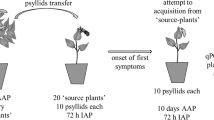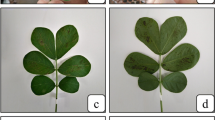Abstract
Through graft inoculation and psyllid transmission experiments, the Cochin China atalantia (Atalantia citroides) was found to be a new alternative host of the fastidious bacterium (Candidatus Liberibacter asiaticus = Las) causing citrus Huanglongbing (HLB). The Las pathogen is commonly transmitted by Asian citrus psyllid (Diaphorina citri) in persistent manner. The Cochin China atalantia plants locally called wild lime (WL) including elliptic leaf (WL-1) and elongated leaf (WL-2) types are growing wildly in Cambodia and Cochin China of Southern Vietnam. The Las pathogen infected Cochin China atalantia plants by graft inoculation and psyllid transmission, and survived persistently. The Las was transmitted from Las-infected Cochin China atalantia plants of two types to healthy citrus plants (Ponkan mandarin) and atalantia plants through psyllid transmission. Therefore, the Cochin China atalantia plants of two types may serve as a new alternative host of Las. Higher titer of Las was detected in the Las-infected WL-1 atalantia plant which developed typical yellow mottling symptom, while lower titer of Las was detected in WL-2 atalantia plant developing mild chlorosis symptom.





Similar content being viewed by others
References
Bayer RJ, Mabberley DJ, Morton C, Miller CH, Sharma IK, Pfeil BE, Rich S, Hitchcock R, Sykes S (2009) A molecular phylogeny of the orange subfamily (Rutaceae: Aurantioideae) using nine CPDNA sequences. Am J Bot 96:668–685
Bové JM (2006) Huanglongbing: a destructive, newly-emerging, century-old disease of citrus. J Plant Pathol 88:7–37
Capoor SP, Rao DG, Viswanath SM (1967) Diaphorina citri Kuwayama, a vector of the greening disease of citrus in India. Indian J Agric Sci 37:572–576
Damsteegt VD, Postnikova EN, Stone AL, Kuhlmann M, Wilson C, Sechler AJ, Schaad NW, Brlansky RH, Schneider WL (2010) The relevance of Murraya paniculata and related species as potential hosts and inoculum reservoirs of ‘Candidatus Liberibacter asiaticus’, causal agent of Huanglongbing. Plant Dis 94:528–533
Halbert SE, Manjunath KL (2004) Asian citrus psyllids (Sternorrhyncha: Psyllidae) and greening disease of citrus: a literature review and assessment of risk in Florida. Fla Entomol 87:330–353. doi:10.1653/0015-4040(2004)087[0330:ACPSPA]2.0.CO;2
Huang AL (1987) Electronmicroscopical studies on the morphology and population dynamic of fastidious bacteria causing citrus Likubin. PhD Thesis, National Taiwan University
Hung TH, Wu ML, Su HJ (1999) Development of a rapid method for the diagnosis of citrus greening disease using the polymerase chain reaction. J Phytopathol 147:599–604
Hung TH, Wu ML, Su HJ (2000) Identification of alternative hosts of the fastidious bacterium causing citrus greening disease. J Phytopathol 148:321–326
Hung TH, Wu ML, Su HJ (2001) Identification of the Chinese box orange (Severinia buxifolia) as an alternative host of the bacterium causing citrus huanglongbing. Eur J Plant Pathol 107:183–189
Lin SJ, Ke YF, Tao CC (1973) Bionomics observation and integrated control of citrus psylla, Diaphorina citri Kuwayama. J Chin Soc Hortic Sci 19:234–242
Lopes SA, Frare GF, Camargo LEA, Wulff NA, Teixeira DC, Bassanezi RB, Beattie GAC, Ayres AJ (2010) Liberibacters associated with orange jasmine in Brazil: incidence in urban areas and relatedness to citrus liberibacters. Plant Pathol 59:1044–1053
McClean APD, Oberholzer PCJ (1965) Citrus psylla, a vector of the greening disease of sweet orange. S Afr J Sci 8:297–298
Reuther W, Webber HJ, Batchelor LD (1967) The citrus industry volume 1: history, world distribution, botany, and varieties. University of California, Division of Agricultural Sciences, Berkeley, California, USA
Su HJ (2008) Research and health management of citrus Huanglongbing in Taiwan. In: Proc Intern Research Conference on Huanglongbing. Orlando, Florida, USA, pp 57–92
Walter AJ, Hall DG, Duan YP (2012) Low incidence of ‘Candidatus Liberibacter asiaticus’ in Murraya paniculata and associated Diaphorina citri. Plant Dis 96:827–832
Yoshida T (1996) Graft compatibility of Citrus with plants in the Aurantioideae and their susceptibility to citrus tristeza virus. Plant Dis 80:414–417
Acknowledgments
Through the international collaboration with Royal University of Agriculture in Cambodia, the present research work was carried out smoothly. The authors thank co-worker, Mr. Setha Vung, for Cochin China atalantia collection and field survey in Cambodia, and deeply appreciate Dr. Shi-Cheng Hung and Ms. Chiao-Wen Huang at Chiayi Agricultural Experiment Branch, Taiwan Agricultural Research Institute for their help of collecting Las-harboring psyllids and Las-free psyllids in the field. The authors are grateful to Dr. Wen-Hsiung Ko, Chair professor of Plant Pathology Department, National Chung Hsing University for his critical review and revision of this manuscript. The present investigation was accomplished under the project grant of the Rural Development Foundation, Taipei, Taiwan.
Author information
Authors and Affiliations
Corresponding authors
Rights and permissions
About this article
Cite this article
Feng, Y.C., Tsai, C.H., Vung, S. et al. Cochin China atalantia (Atalantia citroides) as a new alternative host of the bacterium causing citrus Huanglongbing. Australasian Plant Pathol. 44, 71–80 (2015). https://doi.org/10.1007/s13313-014-0313-8
Received:
Accepted:
Published:
Issue Date:
DOI: https://doi.org/10.1007/s13313-014-0313-8




